 Ulrike Marsky
Ulrike Marsky Field Bioassay or “Pettis test“ to detect varroa mite resistance in the apiary:
What to look out for
By Dr. Ulrike Marsky, Technical Manager, Véto-pharma
Not very long after the first miticides were authorized as a response to the spread of Varroa destructor, beekeepers worldwide experienced the phenomenon of miticide resistance in their apiaries1-2-3. In other words, the treatments they had been using successfully for several years were not efficient anymore.
Resistance develops after repeated contact of varroa mites with a specific active ingredient (chemical substance) over time.4 The chemical substance, killing the mites, imposes a high selection pressure on the varroa population. This means, finding a way to become less sensitive, or resistant, against an active ingredient is literally a question of life or death to the mites. Those mites that are less sensitive towards the active ingredient are more likely to survive a treatment and reproduce. As a result, these mites are more likely to pass on their genes (including those responsible for resistance development against a specific active ingredient) to the next generation.4
Telling resistance apart from other causes of low efficacy or treatment failure is not always easy. Observing and monitoring honey bee colonies throughout the season, and focusing especially on the development of the mite infestation level is crucial in this context. Knowing mite infestation levels throughout the season can help identify “super infested colonies” early on. This is important to prevent the spread of high varroa mite numbers across the whole apiary by treating soon enough. Comparing mite infestation levels before and right after a varroa treatment is an important element of monitoring treatment success in the field, but factors such as re-infestation, migration, or pre-treatment infestation play into the mix, as well.
The global development of varroa mite resistance against different active substances has quickly led beekeepers and researchers to the question: How can beekeepers recognize, with a simple test in the field, whether the varroa mite populations in certain colonies are resistant to one or the other active ingredient?
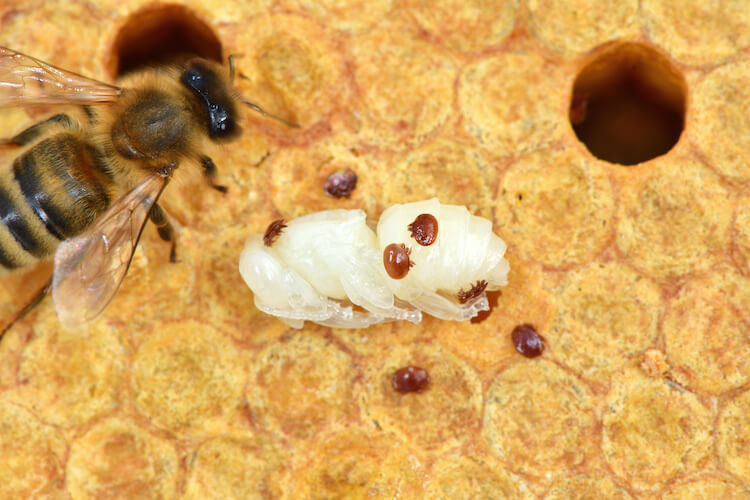
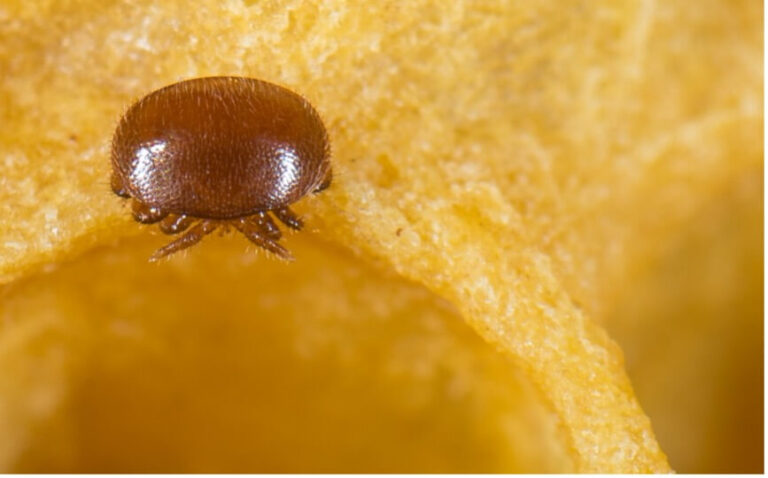
In the United States, the idea of a quick and easy tool for beekeepers to detect resistance in their mite populations in the field first came up in the 1990s when fluvalinate resistance was suspected and later confirmed.3 Dr Jeff Pettis from the ARS’s Bee Research Laboratory, in Beltsville, Maryland and colleagues published a protocol for a field bioassay for beekeepers in 1998.5
The idea behind the assay was to develop a tool that was user-friendly, did not require specialized equipment, and enabled beekeepers to detect resistance before applying varroa treatments – allowing them to increase the survival rate of their colonies as well as to save money and apply a different (efficient) treatment, in case their mite populations were resistant towards fluvalinate.6 In the case of fluvalinate, an assay result of less than 50% mite mortality would indicate resistance, below 25% indicates full resistance.6 So, instead of an “exact science” approach, exposing varroa mites to chemical substances in the laboratory, the goal was to provide beekeepers a simplified, quick tool for the apiary.
The basic principle of field bioassays is this: Beekeepers bring some equipment, including a jar or other container, a piece of the strip of the miticide to be tested, possibly a cup measure, a bucket, white paper, alcoholic solution, and other tools to the apiary. They take bee (and thus attached varroa mite) samples from the brood area of their colonies, taking care that they do not include the queen in the sample. The sample is then exposed to a piece of said miticide strip for a pre-defined period of time. After the incubation time, dead mites are counted on a white bucket or piece of paper. An alcohol wash is performed with the bee sample to detect all mites that were not killed during the incubation time. The mortality rate of mites during the incubation time (exposure to the miticide) can now be calculated. It is assumed to represent the percentage of sensitive mites in the sample (vs. resistant = surviving mites that were not killed during the incubation time).5,7
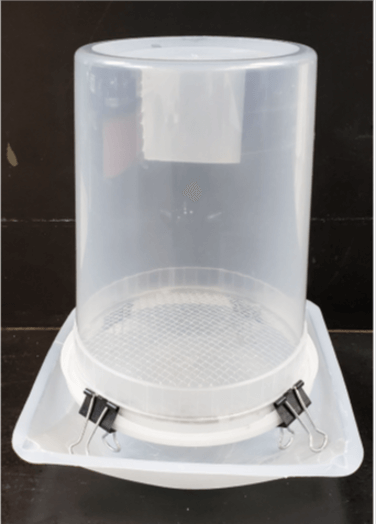
In recent years, amitraz resistance in varroa mites has been reported in some regions of France and the United States.8 Despite the less widespread and more patchy occurrence of amitraz resistance compared with, for example, pyrethroid resistance in varroa mites, several researchers have since worked on the development of a field bioassay for beekeepers that specifically fits this molecule. Most of them have been using the authorized amitraz strip treatment, Apivar, to expose mites in a bee sample to amitraz. Different exposure periods of varroa mites towards the active ingredient (from 2 hours up to 24 hours) have been tested. Different sizes of the piece of the Apivar strip and different methods to fix the strip inside the container with the bee (and mite) sample have been explored.9,10
Some general factors to consider in bioassay protocols include all factors revolving around expiry date and packaging of the testing strips used in the assays. All strip treatments against varroa mites with different ingredients (amitraz, flumethrin, coumaphos) have a specific shelf-life, and each produced batch / lot of the product has an expiry date. Of course, these expiry dates should not only be respected when applying strips as a varroa treatment in honey bee colonies, but also when they are being utilized to detect resistance in the apiary.
Even though the original packaging of the strips has to be opened in order to access them and cut them in smaller pieces for a field assay, shipments of strips or pieces of strips in a different packaging than the original product should be avoided. As soon as the original, sealed packaging of a product is opened, the degradation process due to exposure to air (more precisely, oxygen) and sunlight begins.
In addition to that, the timing of the field bioassays should be considered wisely. For the benefit of colony health, resistance testing before the treatment season is recommended. Beekeepers can thus estimate the sensitivity of varroa mite populations in their apiaries towards a specific molecule before they pick a varroa treatment, but not predict the exact field efficacy of an authorized treatment.
Bioassay protocols to detect amitraz resistance have been proposed by Pettis (2019)9, Higes et al. (2020)10 and others. The different protocols vary mainly in three methodological details:
Pettis (2019) has found a lower mite mortality in assays carried out at temperatures of 70F (21 °C) vs. assays carried out at 90F (32 °C). The protocol of Higes et al. (2020) is relying on a more controlled approach by exposing mites to amitraz at a constant temperature of 34°C (93.2F). The protocol suggested by Rinkevich (2020)11 does not suggest any type of temperature control of the bee (and mite) samples during exposure towards amitraz. Of course, one may argue that the requirement to keep bee (and mite) samples at a constant temperature reduces practicability in the field.
However, the Ministry of Agriculture in British Columbia already published a Pettis test protocol for amitraz in 201512. This protocol suggests several alternatives to provide at least some control of ambient temperature in the field:
“Place the jars in an incubator or a warm room, in the dark, for 6 hours. Alternatively, place jars in a picnic cooler with a couple of hot water bottles. Refill the bottles with hot water after the first 3 hours. Make sure the lids of the jars are not covered so that the bees have air.” The protocol, similar to the original purpose of field bioassays proposed by Pettis, includes the following disclaimer: “This assay is intended to screen for resistant mites and is not intended to indicate the exact level of resistance.”12
The potential effects of temperature on bioassay results should not be neglected in future testing and should be evaluated for different protocols.
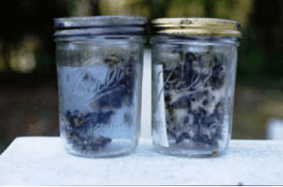
With regards to exposure time, Pettis (2019) and the Ministry of British Columbia (2015) suggest 6 hours of exposure of the bee sample towards amitraz. Shorter exposure times are usually known from laboratory bioassays9-12 or mixtures of laboratory and field assays such as the protocol suggested by Higes et al. (2020)10. The Rinkevich (2020)11 protocol is the only field bioassay protocol (working with bee samples taken from the testing colonies, exposing the samples to strip treatments, and not controlling for ambient temperature) that recommends a shorter exposure period of three hours.11
The relevance of exposure periods of bioassays has been discussed amongst experts as well. Whilst the possibility of obtaining false negative results (= varroa populations falsely classified as “sensitive”) with longer exposure times has been suggested by some, the main factor determining a cut-off time of the exposure period in the field is probably the viability of varroa mites. Looking at the exposure periods suggested in different assays (field and laboratory assays), exposure times usually range between 1 and 6 hours. In laboratory assays, when varroa mites may not have access to food (bees or larvae), viability may play a more important role, and exposure times are usually shorter. However, in field assays with varroa mites being attached to and feeding on their hosts, their natural probability of survival (without exposure towards the active substance) after 3 hours may not necessarily differ significantly from survival after 6 hours. Whether or not an exposure period of 6 instead of 3 hours would significantly increase mite mortality for reasons other than the exposure towards the active ingredient, remains to be demonstrated. As it is the primary goal of a field bioassay to determine sensitivity or resistance towards active substances, the observation of false positive results (= varroa population falsely classified as “resistant”) should be avoided by choosing long enough exposure periods.9-12
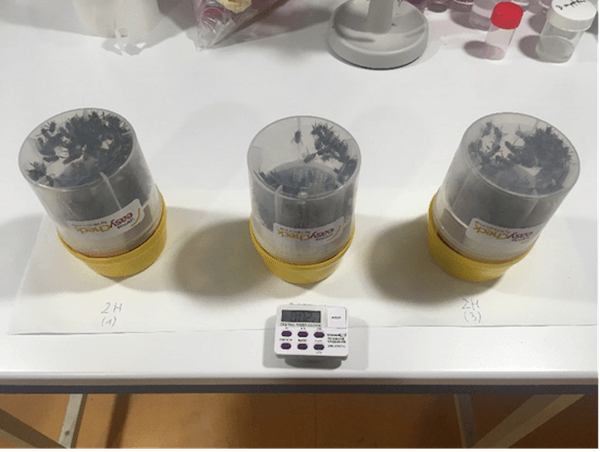
In the protocol of Higes et al. (2020), instead of exposing the whole bee sample, varroa mites are sampled individually and exposed to a piece of an amitraz strip in a petri dish in groups of 15.10 The exposure in assays like this is much less dependent on the activity of the bee sample. The exposure of varroa mites towards the active ingredient is more immediate, as mites directly get into contact with a strip treatment or a petri dish, coated with the active substance. Of course, sampling individual mites and exposing them to amitraz at a controlled temperature is less convenient for beekeepers in the field. However, it does allow for a more standardized procedure under laboratory conditions.
Overall, researchers, technicians and beekeeping experts working on the development of field bioassays to be recommended for broad use in beekeeping, must be aware of the responsibility to weigh accuracy against user-friendliness and practicality in the field. The expectation of beekeepers to carry out quick resistance tests in the field must be recognized, if possible, without discarding methods that may slightly complicate the protocol, but could significantly improve the reliability of assay results in the field.
This is especially important for bee inspectors and/or beekeeping advisors and/or technicians who may recommend conducting bioassays as a diagnostic tool to detect the presence of resistance in an apiary. Such a careful evaluation of bioassay results includes the distinction between mite sensitivity (sensitive vs. resistant) and field efficacy of an authorized treatment, as one is not equal to the other. In fact, the classification of differing percentages of varroa mite mortality in bioassays as “efficient”, “mostly efficient” or “resistant” is well-intentioned, but somewhat arbitrary.15 Continued efforts are required to investigate field bioassay protocols for the detection of amitraz resistance in the apiary and to obtain the best possible balance between satisfying the needs of beekeepers and respecting methodological standards required for reliable assay results.
1- Milani, Norberto. “The resistance of Varroa jacobsoni Oud. to acaricides.” Apidologie 30.2-3 (1999): 229-234.
2- Mozes-Koch, R., et al. “First detection in Israel of fluvalinate resistance in the varroa mite using bioassay and biochemical methods.” Experimental & applied acarology 24.1 (2000): 35-43.
3- Elzen, Patti J., et al. “Detection of resistance in US Varroa jacobsoni Oud. (Mesostigmata: Varroidae) to the acaricide fluvalinate.” Apidologie 30.1 (1999): 13-17.
4- Coles & Dryden, 2014. Insecticide/acaricide resistance in fleas and ticks infesting dogs and cats. Parasites and Vectors: 7:8.
5- Pettis J.S., Shimanuki H., Feldlaufer M.F. (1998) An assay to detect fluvalinate resistance in Varroa mites, Am. Bee J. 138, 538–541.
6- Suszkiw, Jan. “Easy-to-use bioassay spots Varroa resistance.” Agricultural Research 53.4 (2005): 19.
7- Pettis, Jeff S. “A scientific note on Varroa destructor resistance to coumaphos in the United States.” Apidologie 35.1 (2004): 91-92.
8- Hernández-Rodríguez, C.S., Moreno-Martí, S., Almecija, G. et al. Resistance to amitraz in the parasitic honey bee mite Varroa destructor is associated with mutations in the β-adrenergic-like octopamine receptor. J Pest Sci 95, 1179–1195 (2022).
9-Pettis, Jeff S.” Refine and validate a field assay to detect amitraz resistance in Varroa.” Project Apis m. (2019) (unpublished).
10- Higes, M., Martín-Hernández, R., Hernández-Rodríguez, C.S. et al. Assessing the resistance to acaricides in Varroa destructor from several Spanish locations. Parasitol Res 119, 3595–3601 (2020).
11- Rinkevich FD (2020) Detection of amitraz resistance and reduced treatment efficacy in the Varroa Mite, Varroa destructor, within commercial beekeeping operations. PLOS ONE 15(1): e0227264.
12- British Columbia – Ministry of Agriculture. “Pettis Test – Detecting Varroa Mite Resistance to Apistan, Apivar & Coumaphos.” 2015: Apiculture Bulletin #223.
13- Marsky, U. et al. (2020) „Varroa mite sensitivity towards amitraz in France.” COLOSS Conference (October 2020).
14- Almecija, Gabrielle, et al. “Inventory of Varroa destructor susceptibility to amitraz and tau-fluvalinate in France.” Experimental and Applied Acarology 82.1 (2020): 1-16.
15- Morfin, Nuria, et al. “Surveillance of synthetic acaricide efficacy against Varroa destructor in Ontario, Canada.” The Canadian Entomologist 154 (2022).
Join the Véto-pharma community and receive our quarterly newsletter as well as our occasional beekeeping news. You can unsubscribe at any time if our content does not suit you, and your data will never be transferred to a third party!

© 2019-2024, Véto-pharma. All rights reserved